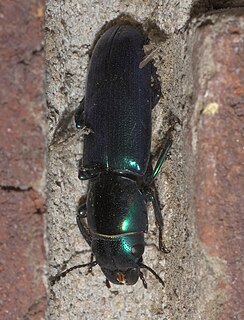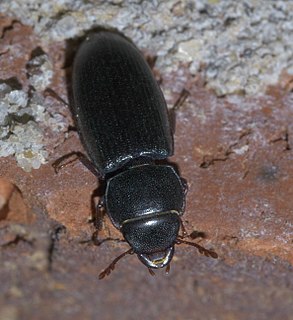
Cleroidea is a small superfamily of beetles containing about 10,000 species. Most of the members of the group are somewhat slender, often with fairly soft, flexible elytra, and typically hairy or scaly.

Ptinidae is a family of beetles in the superfamily Bostrichoidea. There are at least 220 genera and 2,200 described species in Ptinidae worldwide. The family includes spider beetles and deathwatch beetles.

Trogossitidae, also known as bark-gnawing beetles, are a small family in the superfamily Cleroidea. Many taxa formerly within this family have been removed to other families, such as Lophocateridae, Peltidae, Protopeltidae, Rentoniidae, and Thymalidae. Members of the family are generally predatory and/or feed on fungi, both in adult and larval stages, and are generally associated with wood, being found under bark or inside bored tunnel galleries. There are about 400 species in 25 genera in the family under the new, restricted circumscription, as opposed to 600 species in over 50 genera in the old definition. The oldest fossil assignable to the modern, more restricted definition of the family is Microtrogossita from the mid-Cretaceous Burmese amber of Myanmar, which has close affinities to the Trogossitini, indicating that the family had already considerably diversified by this time.

Rentonium bicolor is a species of beetles in the family Trogossitidae.

Trogossitinae is a subfamily of beetles in the family Trogossitidae.

Temnoscheila is a genus of bark-gnawing beetles in the family Trogossitidae, historically often misspelled as "Temnochila". There are about 19 described species in Temnoscheila.

Egoliinae is a subfamily of beetles in the family Trogossitidae. Members are native to South America and Australia. They are thought to be predatory.

Artematopodidae is a family of soft-bodied plant beetles in the superfamily Elateroidea. They are mostly found in understory forest foliage. The life history of the group is obscure, larvae of the genera Eurypogon and Macropogon likely feed on moss, while the larvae of Artematopus have been fed insect remains.The oldest fossils of the family date to the Middle Jurassic.

Grynocharis quadrilineata is a species of bark-gnawing beetle in the family Lophocateridae.

Grynocharis is a genus of bark-gnawing beetles in the family Lophocateridae. There are at least four described species in Grynocharis.

Tenebroides americanus is a species of bark-gnawing beetle in the family Trogossitidae.

Tenebroides is a genus of bark-gnawing beetles in the family Trogossitidae. There are at least 20 described species in Tenebroides.

Tenebroides laticollis is a species of bark-gnawing beetle in the family Trogossitidae.
Mauroniscidae is a family of cleroid beetles, formerly included in the family Melyridae. There are presently five or six genera and roughly 30 described species in Mauroniscidae, all of which are native to the Americas. Almost nothing is known about their biology.

Metaxina is the only genus in the beetle family Metaxinidae. Its only species is Metaxina ornata. It endemic to the South island of New Zealand, where it is associated with sooty mold growing on Nothofagus trees. Both the larvae and adults are likely predaceous, feeding on insects and other arthropods. It is considered to be a member of the superfamily Cleroidea. Genetic studies have suggested that Metaxina should be considered a member of Chaetosomatidae, rather than constituting its own family.

Thanerocleridae is a family of beetles belonging to the superfamily Cleroidea. It was formerly considered a subfamily of Cleridae, but was recently elevated to the rank of family. The family has 36 living species in 10 genera, which are found globally, mostly in low-latitude tropical regions, though the genus Zenodosus is found in temperate North America. Thaneroclerid species are likely all predatory both in adult and larval stages. They target small fungus and wood associated beetles, and are generally found in places where such beetles are likely to be found, typically tree associated habitats such as under bark, though some species occur in other locations such as termite nests.

Lophocateridae is a family of beetles in the superfamily Cleroidea, formerly included in the Trogossitidae. Members of the group have a variety of ecologies, including as predators on other insects, as fungivores, or are phytophagous.

Calitys is a genus of beetles belonging to the family Trogossitidae. It is the only member of the subfamily Calityinae. The genus was first described by Thomson in 1859. The genus contains two unambiguous species Calitys scabra, which is native to Europe and North America, and Calitys minor, which is native to North America. Some species have been reported from South Africa, but these are disputed. The two unambiguous species live on and under the bark of coniferous trees, where they feed on fungi.

Rentoniidae is a family of beetles belonging to Cleroidea. The species were originally included in the family Trogossitidae. They are around 1–2 mm in length, with spherical bodies. Members of the family are native to the Southern Hemisphere, being found in Australia, New Zealand, New Caledonia and South America. They have been found on flowers, under the bark of dead tress, and in leaf litter, and members are known to be pollenivorous or fungivorous.

Thymalidae is a family of beetles in Cleroidea. They were formerly included in Trogossitidae. Members of the subfamily Decamerinae are found in Central and South America, and are associated with flowers, while Thymalus, the only member of the subfamily Thymalinae is found across the Holarctic realm, as well as parts of the Oriental realm, like southern China and Thailand, where they are found associated with the bark of trees. It is assumed that Thymalus larvae feed on fungus in decomposing wood.

















